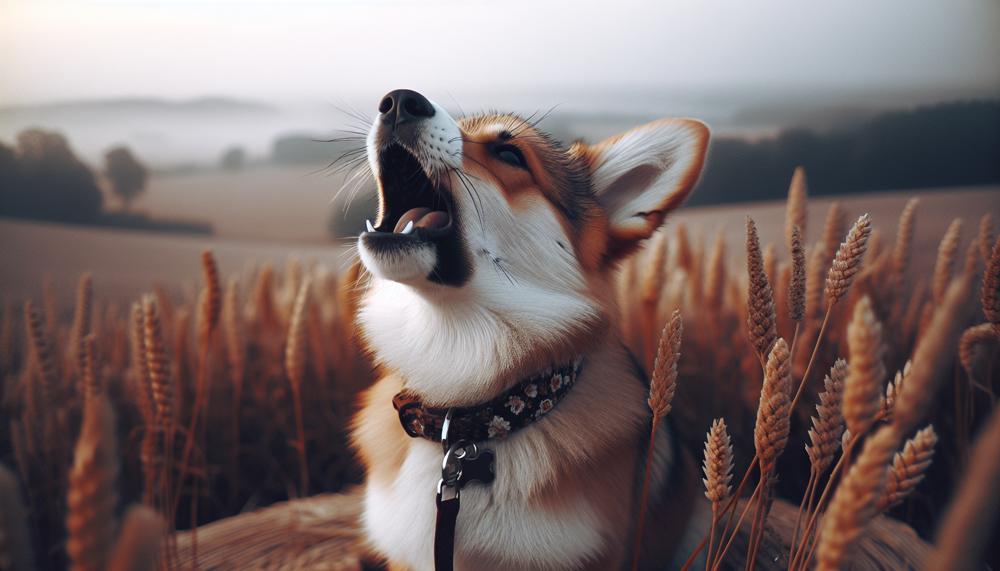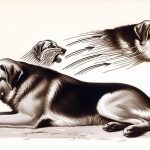As you stand under the moon’s glowing light, you let out a long, mournful howl. Suddenly, your dog joins in with a howl of their own, creating a harmonious duet under the night sky. It’s a familiar scene for many dog owners, leaving them wondering: why do dogs howl when humans howl?
In this blog post, we’ll uncover the secrets behind this unique behavior. We’ll also explore the fascinating world of canine communication. Prepare to discover:
- Howling is an innate instinct for dogs that has been passed down through generations.
- Dogs use howling as a form of communication with both other dogs and their human companions.
- Human howling can trigger a dog’s natural response to join in or seek attention.
- Certain breeds may be more inclined to howl due to their genetic predisposition.
- Understanding why dogs howl in response to human howling can strengthen our bond with our furry companions.
So grab your four-legged friend and get ready to unravel the mystery of why dogs howl when humans do. Let’s embark on this journey together.
Why Does My Dog Howl When I Howl?
Table of Contents [show]
Dogs are highly social animals, and howling is a common form of communication among them. When a dog howls in response to their owner’s howl, they are trying to unite their voices. This strengthens social bonds.
Dogs that are strongly bonded to their owners often show this behavior. They want to take part in the conversation.
Learned Behavior for Rewards:
In some cases, a dog may howl when their owner howls because they have learned to do so in exchange for rewards. For instance, if an owner has previously rewarded their dog for howling along with them, the dog may continue doing so. The dog hopes to receive a treat or attention.
In such situations, it is crucial for owners to avoid rewarding the behavior. Instead, they should reward the dog when they do not howl.
Reacting to Owner’s Emotions:
Dogs are renowned for being highly attuned to their owner’s emotions.
If an owner is feeling sad or anxious and begins to howl, their dog may also start howling. It’s a way of showing empathy and trying to comfort them. This behavior is more common in dogs. Dogs that have a strong emotional connection with their owners are especially likely to display this behavior.
Environmental Factors:
It is also possible that a dog may howl when their owner howls. This may be a reaction to loud or high-pitched noises in the environment. This could be due to the dog’s natural instinct to join in with other dogs or animals making noise. It could also be an indication of anxiety or fear.
In such scenarios, owners must watch their dog’s body language. They should try to identify any triggers causing the howling.
Understanding Your Dog’s Communication and Bonding Behaviors
Dogs howl innately to communicate, a behavior deeply ingrained in their instincts. It is often triggered by their owner’s howls or other environmental factors. It can serve as a means for dogs to connect with their owners and fellow canines.
By understanding the purpose of howling in a dog’s natural communication, owners can better interpret and respond to their dog’s howling behavior. This ultimately strengthens the bond between them.
Emotions, such as joy or loneliness, also influence this behavior. Dogs use it as a form of territorial communication.
Howling generally plays a significant role in a dog’s communication and bonding behaviors with its owner.
| Related Aspects | Explanation |
| Innate Communication | Dogs have inherited the trait of howling from their wild ancestors and it serves as an instinctual form of communication. |
| Bonding with Owner | When a dog hears its owner howling, it may respond by joining in or showing empathy, resulting in a stronger bond between them. |
| Sensitive Emotions | Dogs are highly perceptive creatures and they can sense emotions in their owners, which can influence their howling behavior. |
| Territorial Assertion | In multi-dog households, howling can serve as a way for dogs to assert their presence and establish hierarchy within the pack. |
In addition to being an instinctual form of communication, howling also serves as a vital way for dogs to bond with their owners. When a dog hears its owner howling, it may respond by joining in or showing empathy, resulting in a deeper connection and trust between them.
This can be seen as a primal way for dogs to express their loyalty and affection towards their owners.
Learned Behavior: Rewards and Reinforcement for Howling
This means rewarding desired behaviors in dogs with treats, praise, or toys. Timing and consistency are crucial in positive reinforcement training. Tailor the rewards to the individual preferences and motivations of each dog.
Some common techniques used in positive reinforcement training include:
- Treat-based training: Using highly desirable treats can be a powerful motivator for dogs to engage in desired behaviors, such as howling along with their owners.
- Clicker training: This involves using a clicking sound to mark the desired behavior, followed by a reward. It helps provide precise timing in training and can be especially helpful in teaching complex behaviors like howling.
- Verbal praise: Dogs respond positively to verbal praise and positive attention from their owners. Make sure to use an enthusiastic and cheerful tone when praising your dog for howling together with you.
- Tailored rewards: It is crucial to consider rewards from the dog’s perspective and choose something truly rewarding for them. This could be a specific toy, game, or activity that they enjoy.
It is also essential to note that the rate of reinforcement should be frequent enough to make the training session more exciting than the surrounding environment. In other words, the rewards offered in training should be more enticing than any distractions present.
Using a marker, such as a whistle or clicker, can also help provide precise timing in training. It makes it easier for your dog to understand what behavior you are rewarding.
Emotional Responses: Why Your Dog May Howl When You Do
Your furry companion may imitate your howling behavior. They do this to mirror their pack leader and fit in with their companions. This behavior also shows dogs’ emotional connection and bond with their owners.
Additionally, dogs can pick up on their owner’s habits, including vocalization. They mimic them to build a stronger sense of belonging.
As an owner, you can utilize this behavior to your advantage. Incorporate it into training and reinforce desired behaviors with rewards.
However, it is crucial to ensure that the mimicking behavior is safe for your dog. It should not cause any harm or discomfort.
Emotional Responses: Why Your Dog May Howl When You Do
Dogs are highly social animals that thrive in a pack environment. Therefore, it is no surprise that they often mimic the behaviors of their pack leader – you.
They are trying to fit in with their companions and show their emotional connection to you by imitating your howls. But did you know that this behavior can also have practical benefits when it comes to training?
As a pet owner, it is essential to understand why your dog may howl when you do. You can also utilize this behavior as a training tool. Incorporate howling into training sessions. Reinforce desired behaviors with rewards. This strengthens the bond between you and your furry friend.
However, it is crucial to ensure that the mimicking behavior is safe for your dog and does not cause any harm or discomfort. If your dog seems uncomfortable or distressed while imitating your howls, stop. Find alternative ways to bond with them.

In conclusion, next time your dog starts howling along with you, remember that they are not just trying to copy you. They are expressing their emotional connection and desire to be a part of your pack.
Factors to Consider: Body Language, Triggers, and Context
Body language, triggers, and context play a significant role in a dog’s response to their owner’s howling.
- Just like us, dogs communicate through body language, making it essential for owners to understand their canine companions’ nonverbal cues.
- Triggers are another crucial factor to consider when it comes to a dog’s response to howling. Triggers can be internal, such as fear or anxiety. They can also be external, like a sudden loud noise or an unfamiliar person. These triggers can cause a dog to react in various ways, even if their owner is the one howling.
- Context is also an important element that can influence a dog’s reaction. Dogs are highly situational creatures. Their response to their owner’s howling can vary depending on the environment they are in. For instance, a dog may respond differently at home than they would at the dog park. Additionally, the level of stress a dog experiences in a particular context can also affect their response.
Dealing with the Behavior: When to Let It Continue and When to Intervene
When deciding whether to allow your dog’s howling behavior to persist or intervene, take into account the surrounding circumstances. Consider their body language, how long and how often they howl.
If the behavior appears harmless and your dog does not exhibit any signs of distress or discomfort, it may be acceptable to let it continue.
However, if the howling becomes excessive or out of character, or if your dog seems upset or agitated while howling, it is crucial to step in and address any underlying issues.
You can also seek advice from a certified trainer or veterinarian. They can help you make the most suitable choice for your beloved companion.
Tips for Managing Excessive Howling in Dogs
Dealing with excessive howling in your dog can be a frustrating and tricky task. However, with the right approach, it can be effectively managed. Here are some helpful tips for managing your dog’s howling:
- Determine the root cause: Before attempting to stop your dog’s howling, it’s crucial to first understand why they are doing it. Dogs howl excessively for common reasons, such as loneliness, boredom, anxiety, or seeking attention. Observe your dog’s behavior and try to pinpoint the underlying cause.
- Incorporate regular exercise: Dogs that aren’t getting enough physical activity and mental stimulation may become restless and resort to excessive howling. Be sure to provide daily walks and playtime to help release their energy.
- Establish a consistent routine: Dogs thrive on routine and structure. Create a daily schedule for feeding, walking, and playtime. This will help reduce any anxiety or restlessness that may lead to excessive howling.
- Offer distractions: Leave your dog with a toy or treat that will keep them occupied and distracted from howling. You can also leave the TV or radio on to provide background noise and make them feel less lonely.
- Consider crate training: If your dog tends to howl excessively when left alone, crate training can be an effective solution. This will give them a sense of security and can prevent them from engaging in destructive behaviors.
- Use positive reinforcement: Instead of punishing your dog for howling, reward them when they are quiet. This will reinforce calm and quiet behavior rather than attention-seeking howls.
- Seek professional assistance: If your dog’s excessive howling persists despite trying these tips, it may be beneficial to seek help from a professional trainer or behaviorist. They can assess the underlying cause and provide personalized strategies for managing the behavior.
Conclusion
In conclusion, the phenomenon of dogs howling in response to human howling is a captivating aspect of canine communication. It is an instinctive behavior that has been passed down through generations. It serves as a way for dogs to connect with their owners and express their emotions.
However, this behavior can also be influenced by various triggers and contexts. Therefore, it is crucial for dog owners to pay attention to their pet’s body language and surroundings.
Certain breeds may have a predisposition towards howling. This behavior can also be learned through positive reinforcement. It can also be triggered by loud noises or emotional distress.
We can strengthen our bond with our furry companions by understanding why dogs howl when humans do. This knowledge can also help us manage excessive howling.
Incorporating positive reinforcement techniques is effective. Establishing a consistent routine is also effective. Seeking professional help if necessary is effective. They are all effective ways to address this behavior. They also promote a healthy relationship between owner and dog.






